- This article is a basic buying guide for prospective patrons of Chikankari in Lucknow.
The city of Lucknow is famous for many reasons but Chikankari is, inarguably, one of its greatest claims to worldwide fame. A delicately embroidered white kurta is the first thing that comes to most people’s mind, when the city’s name is mentioned. The city and the embroidery have become synonymous with, and representative of, one another. Rightfully described as poetry on fabric, Chikan is a must-have in every textile collector’s wardrobe.
This article is meant to be a basic buying guide for prospective patrons
of Chikankari. It has been written in a Question & Answer format and
answers some frequently asked questions about the craft.
1. What is the origin of Chikankari?
Many stories are popular in folklore. The most widely accepted theory is
that Chikan developed in the Mughal court, under the patronage of Empress Nur
Jahan. After the decline of Mughal Empire it found favour in Lucknow, where it
flourished profusely.
The word Chikankari is believed to have originated from the Persian word
Chakeen which means creating delicate
patterns on fabric. There are 32 stitches in the repertoire of Chikan but
barely 7-8 of them are used now.
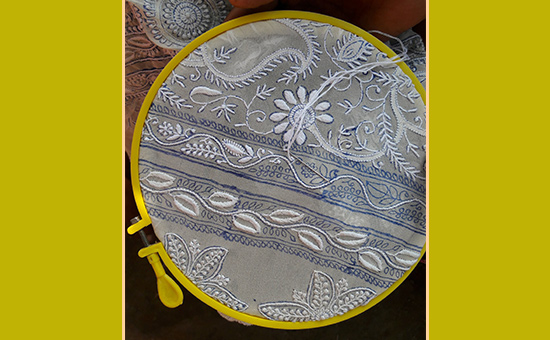 A work-in-progress Chikankari piece.
A work-in-progress Chikankari piece.
2. What kind of clothing is available in
Chikan?
Traditional wear like sarees, kurta sets, kurta pieces, lehenga sets and
dupattas are commonly available in Chikankari, in semi or unstitched form.
Ready-to-wear kurtis and kurtas are also available along with palazzo pants, skirts
and Ghararas. However, high finesse thread-work is available in semi or
unstitched pieces only.
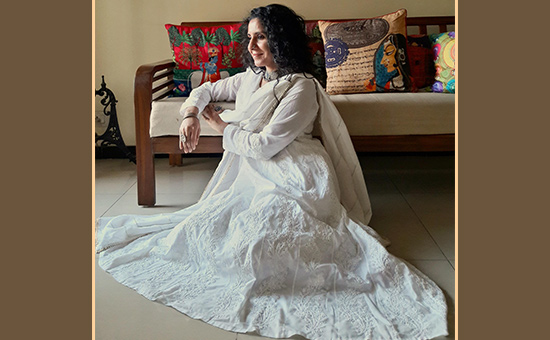 Classic Chikankari, white suit.
Classic Chikankari, white suit.
3. Which materials are used as base fabrics
for Chikan embroidery?
Traditionally, the legendary Dhakai/Murshidabad muslin (now extinct) was
used as the base fabric for Chikan. It was considered luxurious by the
royalty as it was delicate and breathable. It kept one cool in the scorching
summer and humid monsoon of Awadh, in the pre-AC times.
Nowadays, cotton (Voile), georgette and synthetic materials are
used. Kota Doria, Chanderi, organza and silk are also in trend.
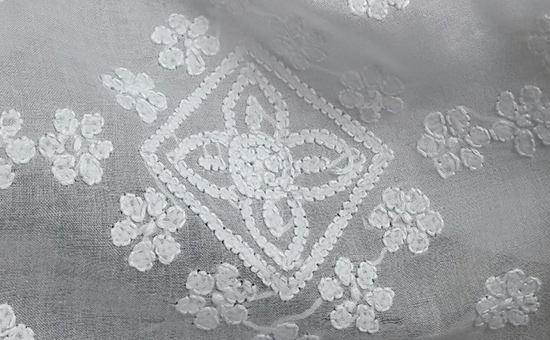 Shadow stitch or Bakhiya on Mulmul cotton.
Shadow stitch or Bakhiya on Mulmul cotton.
4. What colours are available in Chikan?
Conventionally, Chikan embroidery was done with a white thread on a
white base. This combination is still considered the quintessential classic. Although,
all possible combinations like white thread on coloured fabric, coloured thread
on white fabric and coloured thread on coloured fabric are available now, the
combination of white thread on pastel colours (pink, blue, green, yellow,
mauve, beige and off-white) is considered most suited for the craft.
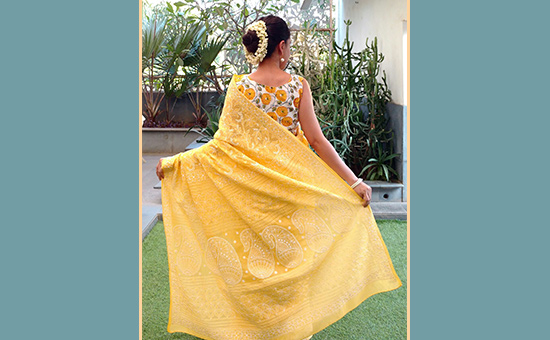 Chikankari on cotton.
Chikankari on cotton.
5. Where to buy Chikan in Lucknow?
Chowk, Aminabad, Janpath (Hazratganj) and Kapoorathala (Aliganj) are the
biggest Chikan markets of the city. Three sources of fine and exclusive products
not easily available in other shops are:
Nazakat Chikan, Janpath market, Hazratganj.
Aaraish by Shivika Singh , near Oudh Gymkhana Club, Qaizerbagh.
Sanatkada J.C. Bose road, Qaizerbagh. Nazakat and Aaraish also sell online via Instagram.
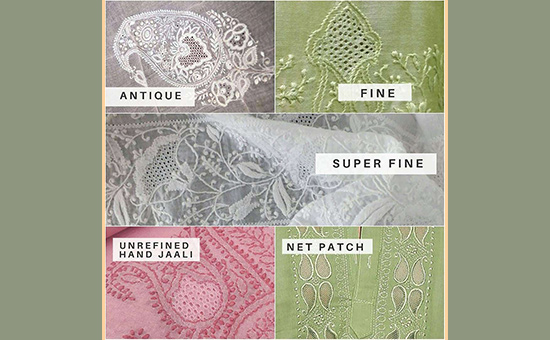 Ascertaining the authenticity and quality of a ‘Jaali’.
Ascertaining the authenticity and quality of a ‘Jaali’.
6. Where can I buy Chikan online?
Meiraas is a Lakhnavi brand that stands out of the crowd. Their products are a unique mix of heritage revival and experimentation with modern aesthetics. Patrons looking for high-finesse, concept-based pieces reflective of Awadh’s history and culture will relate to the brand.
Asya by Ambika creates classic, high finesse pieces on high quality
fabrics, particularly georgettes.
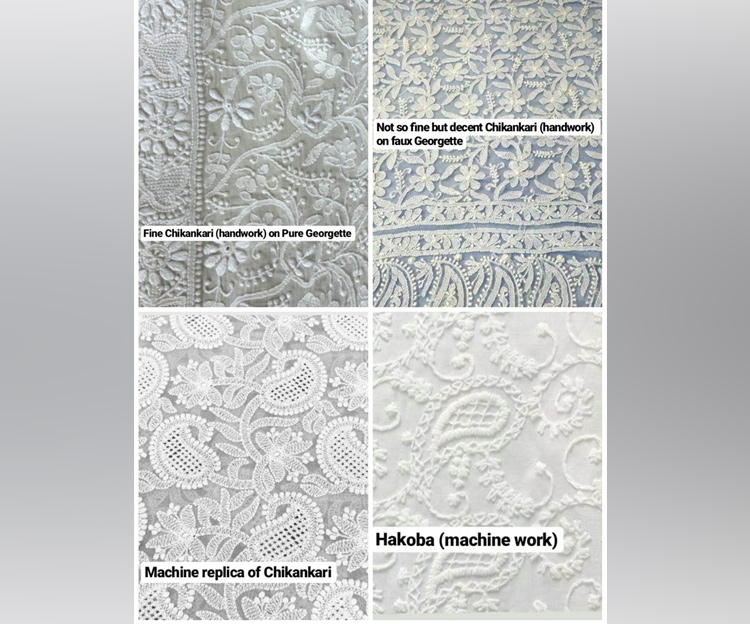 Identifying authentic Chikan.
Identifying authentic Chikan.
7. How do I make sure I am buying authentic Chikan?
Beware of the name
Sewa/ Seva
SEWA or Self Employed Women’s Association is a self-help group that’s been actively working with skilled Chikan Karigars. They earned a
name for themselves because of their work but now hundreds of shops in Lucknow
are misusing their name. The original SEWA has only one outlet in Lucknow in Brahm
Nagar (Sitapur Road) the others are imposters.
Semi-georgette
This is a name most shopkeepers use for faux or fake georgette. Georgette is made
from pure silk yarn while faux-georgette is made from synthetic fibres.
Semi-georgette is a mix of synthetic and natural yarn but it is hardly used
nowadays. Fake georgette is more commonly passed off as semi. Pure georgette fabric
is grainy and translucent while faux-georgette is completely
transparent and rough.
False jaalis
The most intricate stitch of Chikankari is the Jaali. It is
labour-intensive and therefore expensive. Many retailers have started fixing
ready-made nets on the fabric in place of a Haath
ki (handmade) Jaali. It brings down the price and appeals to
some buyers but it is not authentic Chikan.
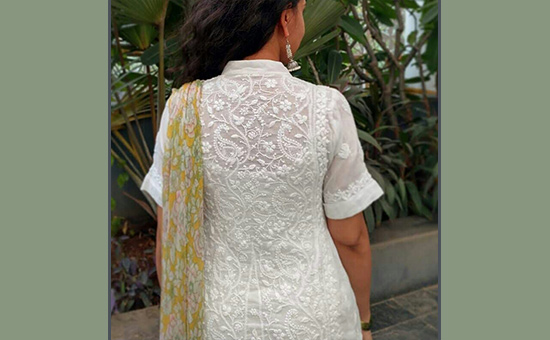 All over lattice work with Hand-made jaali
All over lattice work with Hand-made jaali
Hakoba is not
Chikan!
A kind of machine embroidery called Hakoba is sometimes passed-off as
Chikan. Hakoba is a beautiful textile ornamentation technique in its own right
but it should not be confused with Chikan.
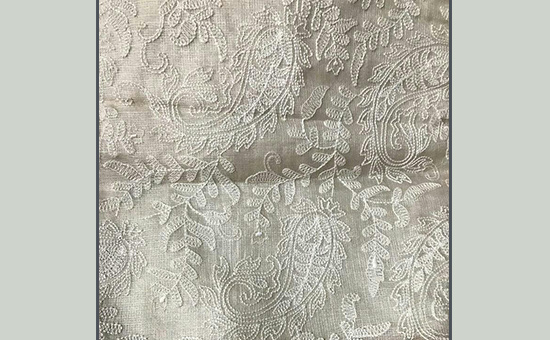 Machine replica of Chikan.
Machine replica of Chikan.
There’s nothing called Machine Chikankari
The term 'Machine Chikankari’, used by some sellers, is not appropriate. Chikan is a handicraft with a Geographical Indication (GI) tag so the term cannot be used for machine embroidery.
To identify authentic handmade Chikan, all one has to do is flip the
fabric and see the reverse side. Look for knots, loose threads and other
irregularities that reflect the human touch.
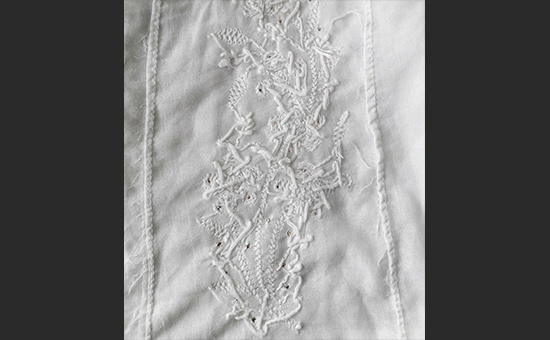 Reverse side of a Boota.
Reverse side of a Boota.
8. Where can I buy something that’s ‘not very expensive’?
Firstly, it’s important to understand the pricing logic of Chikankari products (explained in the next answer) to gauge the fair price of a piece. Secondly, one
must look for something fairly priced not cheap.
One must never forget that Chikan is hand-embroidery and one piece takes
weeks, sometimes, months to take final shape. Selling it cheap would either
mean denying craftspeople their due wages or compromising the quality of the
embroidery.
9. What is the price range for Chikan
products?
Chikan products range from Rs.850 to Rs.1 lakh (not considering the
designer-wear, which can go much higher).
The price of a piece is determined by a number of factors like the
quality of the base fabric, finesse of the embroidery, number of stitches used
and the spread of the embroidery on the piece. Spread means how much embroidery
the piece has, for instance: only around the neck, all-over lattice or sparsely
placed Bootis (motifs) etc. If a complimentary craft like Mukaish or beadwork has been used, then
the price increases accordingly.
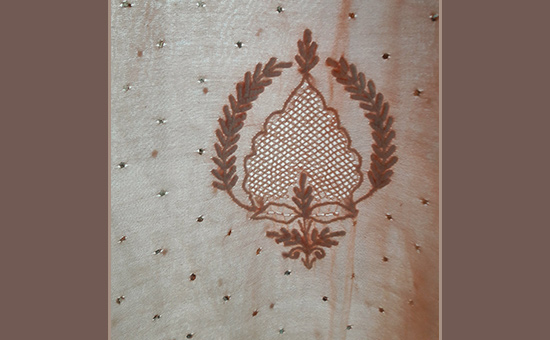 Hand made jaali and Mukaish work.
Hand made jaali and Mukaish work.
A list of product wise prices is given below just to give readers an idea
of approximate prices (as of February 2020).
a. Pure Georgette sarees: Rs 12,000 up to Rs 1 lakh.
b. Pure Georgette suits: Rs 10,000 to Rs 25,000.
c. Cotton sarees: Rs 1,800 and above.
d. Cotton suits: Rs 1,500 to Rs 5,000.
e. Cotton kurta: Rs 1,000 to Rs 4,000.
f. Synthetic kurta: Rs 800 to Rs 2,000.
Lucknow reached the zenith of cultural refinement, which it is still
known for, during the reign of the Nawabs. However, much of that legendary
civilization was destroyed during the 1857 Mutiny. Treasures full of exquisite
artefacts were looted, thousands of highly skilled artisans lost patronage and
artistic legacies were disrupted. Only a handful of resilient crafts survived
that devastation, Chikankari is one of them.
We must never forget how precious this heritage craft is and strive to
invest in it as true connoisseurs rather than mere consumers looking for
bargains.
Author is from Lucknow. She is a Jewellery
Designer, runs www.desidrapes.wordpress.com
and lots more. All pictures are courtesy and copyright author.
eSamskriti.com does not have any commercial interests for featuring names of shops referred to in the article or assumes any responsibility for what you may purchase from the above shops.
To read all
articles by author